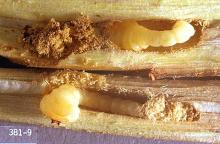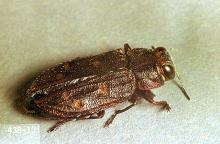Chrysobothris mali
Pest description and crop damage The Pacific flatheaded borer is a pest of many different trees and shrubs, including most fruit trees. Adults are reddish bronze beetles with copper-colored spots on wing covers, and about 0.25 to 0.5 inch long. Larvae are whitish to pale yellow and about 0.5 inch long when fully developed. Just behind the head of the larvae is a broad, flat enlargement giving a "flat-headed" appearance. Larvae feed beneath the bark and may girdle the trunks and branches of trees. Young and recently planted trees are most susceptible, especially when infested host trees are nearby. Trees that are stressed because of drought or other causes are also vulnerable.
Biology and life history This insect overwinters in host plants as mature larvae. In spring, they pupate and then bore exit holes in the tree. They emerge usually from May to June. Females lay eggs from June through July in crevices in the bark, usually on the sunny side of tree trunks below the lowest branches. Stressed trees are the preferred egg-laying site. The larvae hatch, burrow into the wood, and feed on the cambial and vascular tissues until full grown. Burrows are characteristically broad and irregular.
Pest monitoring Watch for depressions in the bark or cracks through which frass (excrement) may be seen.
Management-biological control
Birds peck the larvae from under the bark with their beaks. Some wasp parasites attack the borer. Carpenter ants seek out and eat both larvae and pupae within the wood.
Management-cultural control
These beetles are attracted to weakened, sunburned, or injured parts of the trunk and lay eggs in cracks on bark exposed to the sun. Protect young, newly planted trees from sunburn by white-washing, paper trunk protectors, or shading the trunks with boards. Follow good pruning, watering, and fertilization practices. Keeping weeds, grass, and trash from the base of the trees. This makes it easier for predators to detect and prey on borers. Remove infested limbs and any nearby firewood that may contain borers.
Management-chemical control: HOME USE
- imidacloprid-Plum only. Soil drenches may have residual activity in woody plants lasting for twelve or more months. If short-term management is the goal, consider other approaches.
- pyrethrins-Highly toxic to bees. Some formulations are OMRI-listed for organic use.
- zeta-cypermethrin-Highly toxic to bees.
Management-chemical control: COMMERCIAL USE
No effective insecticides are registered.


